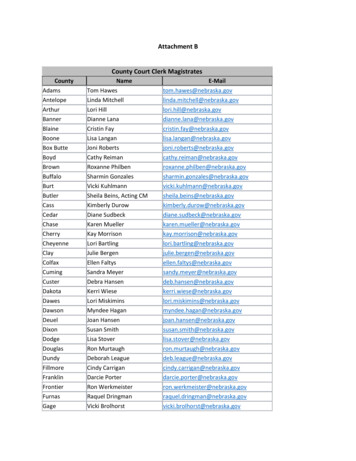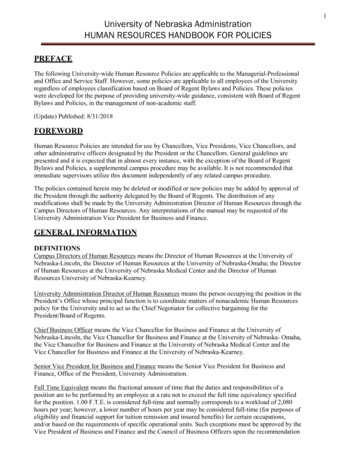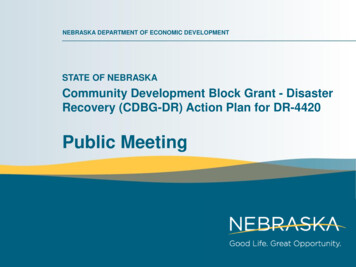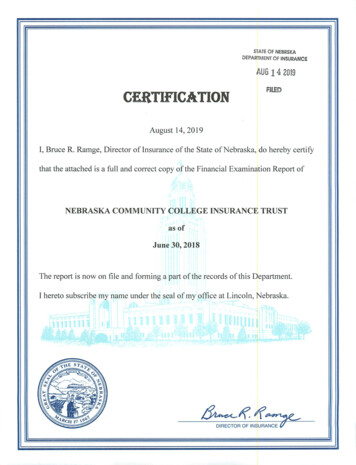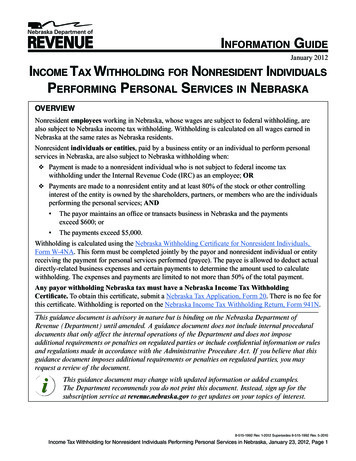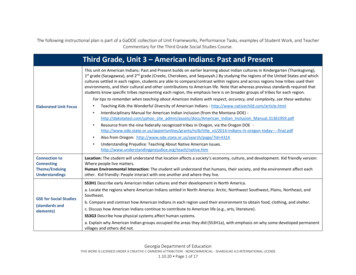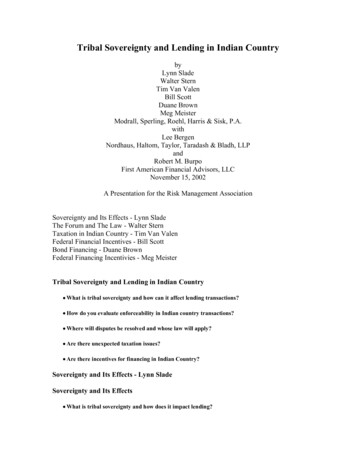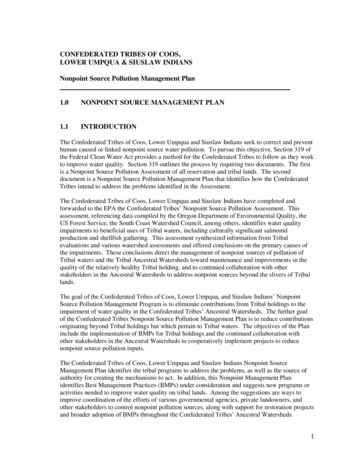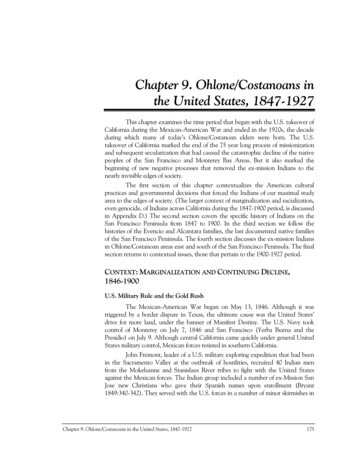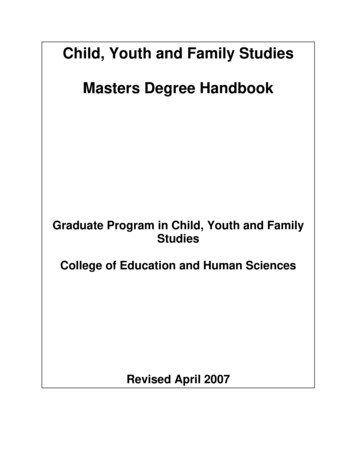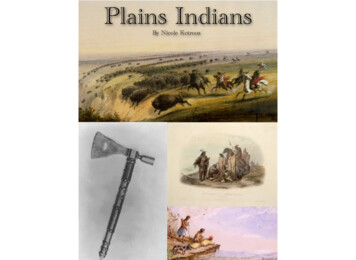
Transcription
Plains IndiansBy Nicole Kotrous
Chapter 1Plains IndiansBy Nicole Kotrous
Chapter 2IntroductionYears and years ago, buffalo and Indiansroamed the plains of North America. It could bethat those very buffalo and Indians roamed inyour backyard! Imagine. it’s a hot summernight, you’re dashing through the seeminglyendless prairie grass. Your bow and arrowsbouncing against your back, sweat tricklingdown your forehead. Your cheeks are blotchyred from running. You look up and meet eyeswith a brutal, ferocious animal. You draw yourbow, and let the arrow go.swoosh! You have hitthe animal. You drop to your knees and beginpraying to your one and only God, WakanTanka. You thank him for once again feedingyour family for another lengthy winter.
Plains IndiansIn the years before European settlers came tothe United States, Native American tribes livedall across the land. Several tribes lived in whatwe call the Plains, or the middle portion of thecountry. I am going to focus on five PlainsIndian tribes. These include: the Ponca tribe,the Omaha tribe, the Pawnee tribe, Sioux andthe Otoe-Missouri tribe. Some of these NativeAmerican tribes were nomadic hunters. Thatmeans that they traveled all year round insearch of plants, animals, food, and freshwater. They also traveled to visit and trade withother tribes. When they traded, they traded forstuff they didn’t have. For example they gothorses, shells, beads, and stone that was softenough to carve, and rock that could bechipped into weapon heads, or points.
Chapter 3HousingNomadic tribes used portable houses such as tipis and livedin villages. Nomadic tribes lived in tipis when they wereaway from their villages, such as when they were hunting.Some tribes such as the Lakota, Arapaho, and Cheyennemostly lived in tipis because they were always on the go.Tipis were often used by the Nomadic tribes because theywere light and portable. Women were often responsible fortaking care of and making the tipis. They were alsoresponsible for putting up the tipis and taking them down.To make a tipis women made a frame of long tall poles.They took the poles one from one and leaned them so theywere in a triangle pyramid shape. The women spaced thepoles so it formed a big circle on the ground. Then theystretched the tipi cover over the poles. The tipi cover wasoften buffalo hides that were sewn together. It took abouttwelve buffalo hides to make one tipi cover. Making a tipicover was hard work. The poles had to be leaned togetherjust right so that the tipi did not fall over. The tipi covermade of buffalo hides had to be fitted on just right to keeprain and wind out.
Section 1TipisThe Native Americans drew symbols on special tipis. A tipi could even tell a story.They might paint a buffalo indicating that they had a good hunt, or the first time theykilled a buffalo. Nomadic tribes had to move their teepees, and to do this, they used atravois. Horses pulled the heavier travois, while dogs carried the lighter ones. To makea travois the Native americans tied a long tipi poles to the sides of a horse or a dog.The other ends of the tipi poles were dragged on the ground behind the animal and5
Section 2EarthlodgesOther tribes had permanent homes, such as Earthlodges.Gallery 3.1 EarthlodgesTribes such as these were sometimes called farming tribes.Farming tribes had villages too, but their villages werepermanent. Twice a year most of the men in the village leftto hunt buffalo. Like the Nomadic tribes, when theytraveled they traded and visited. Non-nomadic tribes mostoften lived in Earthlodges. Long skinny poles aligned theinsides of an Earthlodge. On the outside of an Earthlodgegrass and dirt were packed in to prevent rain and windfrom getting in. The poles supported the Earthlodge, andkept it from collapsing during storms and rainfall. AnEarthlodge was large enough to hold up to forty people.Women dug storage pits in the ground of every Earthlodgeto store dried food. The pits could hold enough food to lasta couple of years! Women also dug storage pits outside.When they left the Earthlodge they would put a pack ofgrass or leaves on top so nobody stole or messed withtheir food. Earthlodges were cool on the inside when it washot out. When it was cold outside, the Earthlodge waswarmed by a fire in the middle of the room. There wasusually a long doorway facing East. It faced East becauseScouts would sit on top of Earthlodges. If something dangerous happened, theywould shout down to the people below to take cover. Scouts also scouted on theground looking for herds of buffalo to hunt.6
Chapter 4BeliefsThe Plains Indians were very thankful and had a deeprespect for Earth and all living things. They believedthat all living things had spirits. The Plains Indiansbelieved that everything they saw on Earth was a partof a web. They believed that they were also apart ofthat web. The Indians protected and cared for theirland. The land on which they lived provided them witheverything they needed, and they were very grateful.They prayed and thanked the animals after they huntedthem for providing them and their family with food.They believed that the land was a gift from the GreatSpirit and it was sacred. They believed that every timethey hunted, ate, and skinned the animal that MotherNature was watching them and making sure that theyate everything and used every bone, skin, and flesh.
The Native Americans followed the “rhythm” of the seasons. Fortogether, they were often called the “three sisters”. The womenthe farming tribes, the crops were planted in the Spring, and thealso grew sunflowers. Small fields of sunflowers were used tobuffalo were hunted in the Summer and Winter. The nomadicmark the edges of each corn field. The village people would eattribes traveled to different places during the seasons as theythe seeds and roots of the sunflower plants.followed the buffalo. Spring, Summer, Autumn, and Winter wereall part of the circle of life, and every new season brought a newceremony. The Plains Indians’ ceremonies were very religious,and interesting. For the farming tribes Summer was an extremelyimportant time. It was important because that was when theyplanted their corn and danced in their Summer time ceremonies.In April they had ceremonies before they planted their corn. Oncein an Omaha Village, a dancer pretended to be a corn stalk, andwhile the tribe sang, the dancer pretended to be a corn stalkgrowing! Some Pawnee danced like they were hoeing or plantingcrops while the rest of the tribe sang about corn and prayed.Plains Indians had a lot of religious ceremonies. In a religiousceremony, Eagle feathers were awarded to those who actedbravely. The Plains Indians had their own ceremony called the“Sun Dance”. The “Sun Dance” is for the Sun God and asking thesun for strength and help their tribe. Each tribe had their own“Sun Dance”. It usually took place in summer and lasted for fourdays and nights. The performer would have their face paintedwhile others blew the eagle bone and played drums to call thethunder bird. They did this for all four days, except for the last daywhen they went without food or water. The Sun Dance involvedthose who pledged to sacrifice themselves. Medicine menWhen the corn ceremonies were finished the women and the(Shamans) looked at the sun for God’s vision. In return they werechildren would start to plant the seeds. The Indians would plantgiven the ability to heal people.the corn in between the cornstalks. Out of all the crops andplants, corn was planted first. When the corn began to grow, thewomen would then plant the beans. The beans grew up andaround the corn stalk. After everything had sprouted and beganto grow, they would began to plant many different types of squashand pumpkins. The vines from the plants covered the groundbetween the cornstalks. The vines also helped keep the peskyweeds away! When corn, beans, and squash were planted8
Chapter 5FirstEnvironmentalistsThe Plains Indians did not waste anything! They usedeverything from buffalo fat for soap, to their tendonsfor sewing. How would you like to use buffalo fat forsoap? This shows the ways they used a buffalo: Theyused the horns for cups, headdresses, ladles,insturments and toys. They used the bladder forpouches and medicine bags. They used the stomachfor buckets, cups, dishes, and other containers. Buffalohide was used for bedding, belts, cradles, dolls,dresses, gun cases, leggings, moccasin tops, paintbags, pipe bags, pouches, shirts, tipi covers, and winterrobes. They used buffalo chips for smokingceremonies, and fuel for cooking fires. They usedbuffalo hair for halters, pillows, and ropes. The skullwas used for prayer and ceremonies.
The Plains Indians used every part of the buffalo. Here are some examples: Fat; Soap, and Cooking Oil. Bones; Knives, ArrowHeads, Shovels, Scrapers, Winter Sleds, Saddle Trees, War Clubs, Game Dice. Dung; Fuel. Stomach; Buckets, Cups, Dishes,Cooking Pots. Hooves; Glue, Rattles. Hair; Headdresses, Saddle Pad Filler, Pillows, Ropes, Halters. Beard; Ornaments forweapons. Tongue; Best Part of the Meat. Skull; Altar at Religious Ceremonies. Brains; Hide Preparation. Horns; Cups, Spoons,Ladles, Headdresses. Tail; Decorations, Fly Brush, Whips. Muscles; Sinew, Meat for Jerky. Tanned Hide; Moccasins, Cradles,Winter Robes, Shirts, Leggings, Belts, Dresses, Pipe Bags, Quivers, Tipi Covers, Gun Covers, Dolls. RawHide; Containers, Shields,Buckets, Moccasin Soles, Belts, Headdresses, Medicine Bags, Drums, Ropes, Saddles, Stirrups, Knife cases, Quirts, Armbands,Bullet Pouches.10
Movie 5.1Plains IndiansmuseumClick on the play button to see a Plains Indians Museum. In this video I will show you NativeAmerican artifacts and replicas. Two real Native American artifacts in this video are the blue,white, and orange beaded moccasins, and the hair pieces. Everything else shown is a replica.For example a replica would be the talking feather, or the Indian doll with clothes. Thereplicas are good examples of what the Plains Indians would use and have. Thanks forwatching! Click on the picture for further information:11
Chapter 6HuntingThe Plains tribes had two big hunts every year, one inthe Summer and one in the Winter. Preparing for thebig Summer hunt could be a big job. They prepared bymaking sure they had enough good arrows. Everyonegoing on the Summer Hunt had to make sure theirhorses were all rested. Not only the Indians needed toprepare, but the animals needed to be ready as well.Most of the time the younger boys were in charge oftaking care of the horses. They would prepare bymaking sure they had a lot of rest, and had grazed onthe grass. It was important that they did these thingsso when the Indians got into a good buffalo chase theycould keep up!
Section 1HuntingThe most popular and well known weapon Native Americans used would have to be the bowand arrow. Nearly every Native American tribe used a bow and arrow. Some tribes, moretowards the South used bow and arrows for fishing. Bows and arrows are so accurate andresourceful that they have been used since the Stone Age. The earliest arrowheads found are13,000 years old! Most Native American bows were made of wood. The most powerful bowswere wrapped around with animal tendons to make them more flexible.Plains Indians also used tomahawks. Tomahawks are axes formed from wood and sharpenedrock or stone. Tomahawks were prized for their versatility because they could be used in somany different ways: thrown short distances, used as a tool, or in hand-to-hand combat.Most of the village would go on the summer hunt, but others would stay behind because theywere too old or too ill to go on a long lengthy hunt. Before the Omaha villages left for the bighunts they would have ceremonies. They would sing, dance, and pray for hours telling thecreation stories of the Buffalo. Ceremonies that were before the hunts were in prayer to theSpirit of the great animal. Both nomadic and farming tribes had hunting ceremonies. Huntingwas very dangerous. It is very common to hear stories about men hit with a stray arrow or runover by a buffalo herd. These tribes had ceremonies to say goodbye to their hunters, just incase they did not return with the rest.13
Section 2FoodPlains Indians needed a lot ofdried food to go on a hunt. TheDFRRmost common food the PlainsIndians ate was the buffalo.When going on a hunt thewoman would hang the strips ofbuffalo on a pole and let it dry.The buffalo would dry andbecome jerky. If jerky was madeIright it could be eaten for twoyears.Some fruits and vegetablesEthat the Plains Indians ateincluded: squash, pumpkin,apples, and cherries. Thesecould also be dried and takenon the hunt.DFruitsUITSApples!14
Chapter 7CommunicationsThe Plains Indians had many interestingmethods of communication; from writingon buffalo hide, to using mirrors to signalstreaks of reflected light! The PlainsIndians did not have a written languagelike us with letters and words, insteadthey used drawings and cave walls, orsmoke. It might be just me, but I thinkthis would be a fun and challenging wayto speak.
Section 1SignalsFire Signal:Fire signals were used at night. During a fire signalthe person trying to communicate or get help wouldlight the fire, and then run in front of it or around it.Indian scouts could decode this signal easily.Running around the fire meant danger was aroundand to “go away, get out of here”!Smoke Signal:A common signal used in the Plains was a smokesignal. Because the Plains were flat, smoke signalscould be seen for miles. By changing the puffs ofsmoke, from short to long is how they sent andtranslated their message. Some messages were awarning, others were just as simple as “come home,supper’ ready”.16
Blanket SignalsBlanket signals were used by warriors. They were used tocommunicate to someone that might not hear them, but couldsee them. A waving that was in a wild manner meant dangerand to get away as fast as possible. It got the tribe a few extraprecious moments to get ready for an attack.Mirror SignsThe Plains Indians did not invent the mirror, a white manbrought it to their camp. But they came up with a creativeway to use it as a signal. You would think that because thePlains people traded for a mirror that they would want tosee themselves. Not even close. They used the mirror as asignal. By pointing the mirror straight at the sun, reflectiverays would shoot into the sky warning people with in milesthat there was danger. This was also a very common signalused because the mirror was portable and the signal couldbe sent while on horseback.17
Picture SignalPlains Indians wrote on cave walls, rocks, and scraps of buffalohide. These pictographs told the stories of their daily life, theirheroes, and their battles. These drawings on cave walls androcks can also be warnings.Sign LanguageNot all Plains people spoke the same language. Tocommunicate with other tribes, including their own, theydeveloped a language using hand movements. Thislanguage was and still is called “sign language”. Over timethe language spread and all Plains tribes were using it.Usually each tribe also known as a band had a “talker”. Thiswas a person that could translate the sign language byspeaking it. The “talkers” understood over three thousandsigns! Some of the “talkers” could sign as fast as you canspeak!18
Review 7.1Question 8 of 8Name one form of housing for the Plains Indians?A. Log cabinB. Sod houseC. TipiD. Brick houseCheck Answer19
Chapter 8Pawnee tribeThe Pawnee traveled to Nebraska ages ago. The Pawneepeople called themselves Chahiks si Chahiks, which means“men for men.” The Pawnee Indians spoke a Caddoanlanguage. The Pawnee Indians lived or could be found amongthese rivers: Platte, Loup, and Republican Rivers. PawneeMen and women had very distinctive roles in everyday life.While the women did labor, younger women would watch themand learn their responsibilities. The elderly women were incharge of looking after the younger children of the tribe whilethe women worked. The men were classified into threegroups. There were the medicine men, priests, and thewarriors or hunters.
Section 1PawneeThe Pawnee Indians maintained a good relationship in between the Gods and nature. The Pawnee Indiansbelieved that to have a good crop that they had to plant the crops according to the position of the stars. This wasBecause they believed that the stars were associated with the Gods. The Pawnee Indians believed in Gods. Theirmain God was Tirawa. The Pawnee Indians believed that the stars at night were night Gods and that the sunmated with the moon and created the first boy who was on Earth. The Pawnee Indians are a very important tribein Nebraska History. They were known to sacrifice maize and other crops to the the Gods. They even sacrificedhumans at times, until the eighteenth century. When the white settlers came to the plains, they brought diseasesthat were new to the Indians. Pawnees had to deal with loads of sicknesses. The wide-spread disease of bothSmall-pox, and Cholera were responsible for wiping out most of the Pawnee Indian tribe in the nineteenthcentury. In 1900 there were only 600 Pawnee Indians left. However, in 2005 there was a population of 2,500Pawnee Indians. That’s almost 2,000 more Pawnee Indians! The Pawnee Indians mainly ate buffalo and corn.They mainly ate corn because it was sacred to them. They even called it “mother”. The tribe’s main source offood came from when the Pawnee men went on the big Summer hunt. The Pawnee Indian tribe lived in a homecalled an Earthlodge. It was a dome shape and was packed with dirt from the earth and sod. They wore clothesmade out of Buffalo skin. In the summer the men would wear a breechcloth and moccasins. In the winter itwould get much colder so the men and women would add leggings and a robe made out buffalo skin. Theirsummers were very hot and their winters were very cold. The Pawnee Indians lived in a very resourceful areawith small streams perfect for sleeping, and rich soil for nutritious plants in the woods. The Pawnee Indians werenomadic. This meant they didn’t plant or have permanent houses. Their villages weren’t even permanent!21
This is a good example ofwhat the NativeAmericans wore andhow they wore theirfeathers. The mostcommon feathers theywould wear were: BaldEagle feathers, andTurkey Feathers.22
Interesting Facts:Fun Facts·The Pawnee men would shave their heads, except for a small scalp lock which they later put paint and grease into to make itstand up and look like a horn.·There are 2,000 Pawnee people left today.·Before the Pawnee had horses they would chase the buffalo down hills because they thought this made hunting the buffaloeasier.·In 1856 the Pawnee population was almost wiped out by smallpox, Cholera, and Sioux attacks.·The Pawnee Indians were excellent hunters.·There were four Pawnee tribes: The Chaui, Kitikahki, Petahauiria, and Skidi.·The name of a famous Pawnee leader was Crooked Hand who was famous for getting out of his sick bed and organizing afighting force by gathering elderly, children, and sick warriors to fight the Sioux. Forced to move onto a reservation in the 1800’s.23
Review 8.2Question 5 of 5Around what time were the Pawnee Indians forced tomove onto a reservation in Oklahoma?A. 1800’sB. 1900’sC. 1750’sD. 2000’sCheck Answer24
Chapter 9Ponca tribeThe Ponca tribe was never really a verylarge tribe. The tribe’s size was estimatedto be about 800 Indians in 1780. By1804 their numbers dwindled down to200 Ponca Indians. Even today the tribeis somewhat small with only 3,500Indians. The Northern Ponca Indians arestill living in Nebraska today.
Section 1PoncaThe Southern Ponca Indians were forced to move onto an Indian reservation during the 1800’s. The Ponca tribe had towalk 500 miles from Nebraska to Oklahoma. So many people died that it was called the “Trail of Tears”. The Trial ofStanding Bear was a very important moment in the Ponca tribe history. The Ponca tribe was forced out of their homelandand was moved to a reservation in Oklahoma. The Trial of Standing Bear happened in 1879. They went from NortheasternNebraska to Indian Territory in Oklahoma. Many people died along the way, including Standing Bear’s daughter, and whenthey reached their destination, Standing Bear’s son died. Standing Bear’s sons dying wish was to be buried in hishomeland Nebraska. Standing Bear and a small band of his men began the dangerous journey home to bury his belovedson. They realized what they were doing was in defiance of government orders of not leaving the reservation. They weresoon arrested and about to be returned to their Indian reservation, when their story got published in the Omaha DailyHerald. Standing Bear was held for trial at a fort near Omaha. The outcome of everything that had happened wasimportant. His son and daughter had died, and Standing Bear had gone against the white man’s rules. But it had all paidoff. The word “Indian” was finally equal to a person.Standing BearSpeechVoiced byJaxon Holler.26
Ponca Population Over Time4000300020001000017801804201427
Section 3LanguagesTypetoentertext·Here are some words that the Ponca Indians would say often in their dailylife:·Wasabe. ‘grizzly bear’·Deagheta. ‘many people’·Nakoponza. ‘elk’·Mohkuh. ‘skunk’·Moukou. ‘medicine’·Washaba. ‘buffalo’·Wazhazha. ‘snake’·Nohga. ‘medicine’ (another word for ‘medicine’)·Wahga. ‘ice’·Waga. ‘Jerky, meat”28
Interesting Facts: The Ponca Indian tribe ran into and met Lewis and Clark in the year 1804. When they met Lewis and Clark, their numbersdwindled down to around two hundred Ponca Indians. The Ponca didn’t speak the same as the English. They spoke a language that is confusing to many but unique in its own way. You pronounce Ponca like pawn·kah The Ponca Indians were a nomadic tribe. The children enjoyed having contests that included eating the most wild goose berries, running the fastest, and makingarrows quickly. They were friends with the Omaha tribe. The Ponca tribe lived near the Niobrara river. Ponca, Otoe, and Omaha were all very close and spoke languages that were alike. Ponca were thought of as the most successful Indian farmers. One of their favorite desserts was wild honey mixed with nuts.29
Review 8.3Question 5 of 5What came out of the trial in Omaha, Nebraska?A. Ponca people didn’t have to move onto areservation.B. They got to leave.C. Indians were considered people.D. They got to go to school.Check Answer30
Chapter 10Omaha tribeThe Omaha tribe originated or began in the early1500’s. The Omaha tribe settled by the Missouri river,also known as the mouth of the river. Their namemeans “Upriver People”. The Omaha Indians are theoriginal tribes of Nebraska and Iowa. Most Omahapeople are still living there today. Most Omaha peoplespeak English today, however many Omaha, especiallyelders also speak their Native Omaha-Ponca Languagewhich they share with their close to tribe the Poncas.An easy Omaha word is “aho” which is a friendlygreeting. Today, the Omaha language is considered anendangered language because most children aren’tlearning it anymore. But their are Omaha people thatare fighting to keep the language alive.
Section 1Omaha TribeThe Omaha tribe children did just as any other children would do they would playedwith each other, went to school, and helped around the house. Most Omaha childrenliked to go hunting and fishing with their fathers. In the past, Indian kids had morechores and less time to play. You could say they were like colonial children! But whenthey did have time to play they would play with dolls, toys, they even played a gamecalled hoop game. In this game you have a long dart and you try and make it into acircular hoop while the third player is rolling the hoop along the ground, while the twoother players tried to make their dart go through the circular hoop. The Omaha tribelived in an Earth lodge in the winter, in the summer they changed their houses intotipis so they got more air. The Omaha tribe is famous for their arts and crafts, mainlyfor their quilling, beading, and hide paintings. The Omaha Indians believed in32
Section 2Omaha LegendThe Omaha have many legends that they passed down to their young. This legend is one of the most common legendsknown from the Omaha Tribe.“The Omaha people began in water. Their eyes opened and they could not see anything. They came out of the water, butthey didn't have clothes on. After days passed, they wanted clothes. They got fiber from weeds and grass and wove themtogether for clothing.After this they started to make grass houses. The Omaha people lived by a lot of water in the forest where there wereanimals. They did not have any arrows, so they hit the deer with sticks. The Omaha people wandered away from the edgeof the water. The people thought about what they would do to help themselves. They found a stone that was flaked andthey made knifes and arrows out of it.Then one man found some white, blue, and red kernels. He thought he had found something worth something so he hidthem in a mound. When he went to check on them, he saw stalks of corn which he shared with the people. They found outit was good for food.In early days, the Omaha people wore grass clothes and threw buffalo hides away and didn't use them for anything. Theyfigured out how to scrape the buffalo hides and use them for clothes. They used grass also for tepee covers but thatwould not work so then they used deer skin. That was too little so then they tried elk skin. But in the rain it turned hard.Then they tried buffalo skin. That was just right!”33
Interesting Facts:·Omaha is pronounced “oh-muh-hah” but in their own language the name sounds more like “u-mahn-hahn”, with nasalvowels.·They mostly lived in Earthlodges, but also lived in tipis when they were on a buffalo hunt.·The Omaha tattooed someone when they won a battle, the wife was sometimes tattooed too. If the wife was tattooed shewould become a more valuable wife.·The Omaha believed that the sky and sun were father and Earth was mother.·When it rained the Omaha tribe believed that if they didn’t tell stories or legends they would have bad luck.·Girls would play stick ball and boys would play dare. Dare could be very dangerous. If you didn’t do the dare that theydared you, you would owe the darer something.·The men of the Omaha tribe wore leggings and moccasins. They would wear a feather if they won a battle.·The women of the Omaha tribe wore leggings and dresses and braided their hair.34
Review 8.3Question 5 of 5(In the sacred legend) Did they waste anything?A. YesB. NoCheck Answer35
Chapter 11Otoe-MissouriaAt one time the Otoe and the Missouri,the Winnebago, and the Iowa tribes wereonce all part of one single tribe that livedin the Great Lakes region of the UnitedStates. In the sixteenth century the tribesseparated from each other and migratedWest and South.
Otoe MissouriaRecipe1 whole pumpkin1 bag dried sweetcornCinnamonsugarThe Otoe Missouria were predominately hunter-gathers. TheyDirections: Remove seeds and “guts” from pumpkin. Cut mean fromboth grew and harvested. They grew and harvested corn,rind. Cube pumpkin meat and place pumpkin in pot on stove. Cook untilbeans, and squash. But their diet was mainly made up of thesoft. Boil dried sweet corn. Corn is cooked when it is soft. Once cooled,animals that surrounded the plains. As an Otoe-Missouriacombine cooked pumpkin and corn. Add cinnamon and sugar to taste.tradition the tribes would migrate to follow the buffalo. TheyThis amount varies depending on the size of your pumpkin and yourstayed in the general areas of Nebraska, Kansas, Iowa, andMissouri. Where the Otoe-Missouria tribe settled had verypreference. Add sugar slowly. You do not want to add too much sugardesirable land on which many wanted to farm. As more andso that the flavor of the pumpkin is overwhelmed by sweetness. Themore people came, the Otoe-Missouria fought to protect theircombination should result in a gently sweet, pumpkin combination withland. Although the Otoe-Missouria were a small tribe theya pleasant spice hint. VARIATION: Another tribal member recommendsfought bravely until the 1850’s when the United Statesusing brown sugar instead of white sugar and cinnamon. Remembergovernment confined the Otoe-Missouria tribe and took themto the Big Blue Reservation. Being on the reservation washard. The Otoe-Missouria couldn’t hunt for buffalo. The Otoe-that our ancestors didn’t use measuring cups and spoons. Learn totrust your own palettes and experiment with the balance of flavors.Missouria watched as the white settlers sawed off their landacre by acre and sold it to non-Indians.37
This is a diary entry from what life was like on a Native American reservation;“My Indian name is translated to ‘Standing on the Earth’. We practically always had white people withus because my father always hired hands of different nationalities. Mother was busy housekeeping andshe had to cook for and take care of the hired hands. My father was hardly home because he was thecaptain of police and all his time was at the agency. So mother and grandmother had to carry on thehome work and I was just a little girl When my father and mother got married and they got started, hewas kind of a policeman. They had range riders. The north, west, and south boundaries of thereservation, there was an Otoe would ride that line every day. Dad got that job on the west line overthere, riding it north and south. This was before allotment, and they could live wherever they wanted toon the reservation, so to be close, Grandma said best to move over there. So they built a cellar overthere near the west line. And course Dad’s ‘brother’ Burgess was handy -- he learned carpentry atHampton -- so they bought lumber and they built kind of a three-room shack over there. Every day myfather rode the li
ceremony, Eagle feathers were awarded to those who acted bravely. The Plains Indians had their own ceremony called the "Sun Dance". The "Sun Dance" is for the Sun God and asking the sun for strength and help their tribe. Each tribe had their own "Sun Dance". It usually took place in summer and lasted for four days and nights.
